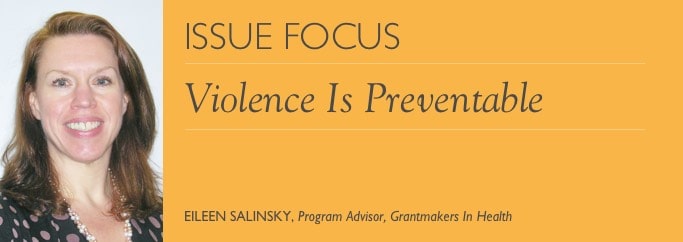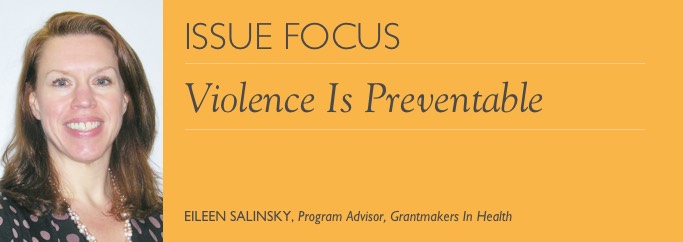March 2018

Mass shootings command public attention, but for too many Americans violence is a threat that must be confronted every day. Violent crime, although low relative to historical rates, has risen in recent years and disproportionally affects poor, racially segregated, urban neighborhoods (U.S. Department of Justice 2017; U.S. Department of Housing and Urban Development 2016). One study found that 26 percent of all gun homicides in 2015 were concentrated in neighborhoods representing just 1.5 percent of the U.S. population (Aufrichtig et al. 2017).
The number of murders in the United States—17,250 in 2016, an average of 47 each day—is shocking, but non-fatal violence is far more common (U.S. Department of Justice 2017). Non-fatal violence, including rape, robbery, and aggravated assault, accounts for nearly 99 percent of all violent crimes reported to police (U.S. Department of Justice 2017). Incredibly, over half of the estimated 5 million incidents of non-fatal violence experienced by Americans in 2015 were not reported to police and are not reflected in official crime statistics (Truman and Morgan 2016). Approximately 20 percent of all non-fatal victimizations are classified as domestic violence (i.e., violence committed by an intimate partner or family member). Non-fatal incidents of domestic violence are reported to police at higher rate (57.7 percent) than all non-fatal incidents of violence (46.5 percent) (Truman and Morgan 2016).
Youth and the poor face the highest rates of violence victimization (Truman and Morgan 2016). Young men and boys of color face particularly high risks. Homicide is the leading cause of death for African American males age 15 to 34. These young men and boys experience a homicide rate (79 per 100,000) nearly 14 times greater than the national average and nearly 10 times greater than white males in the same age cohort (Centers for Disease Control and Prevention 2015b, 2015a).
Victims who survive violence experience significant health problems. Approximately one-quarter of non-fatal violent events result in physical injury (Truman and Morgan 2016). Hospitalizations and emergency department use related to violence accounted for more than $8 billion in medical costs in 2010 (Centers for Disease Control and Prevention 2010).
The physical, mental, and emotional consequences of violence often extend far beyond the immediate aftermath of victimization. A wide body of research related to trauma, adverse childhood experiences, and crime victimization demonstrates that exposure to violence has a negative influence on multiple health and quality of life outcomes, including increased incidence of anxiety and stress disorders, chronic diseases later in life, decreased academic performance, compromised parenting skills, impaired occupational functioning, unemployment, and problematic social relationships (Hanson et al. 2010).
In addition to the direct harm experienced by victims, violent events also traumatize witnesses, victims’ family members, and other residents of high-crime neighborhoods, resulting in collective or community-level trauma (Davis et al. 2015). The same community disadvantages that increase the risk of violence, such as poverty, community deterioration, social isolation, and failing schools, are also further exacerbated by violence, perpetuating a cycle of community trauma and poor community health outcomes (The Prevention Institute 2015).
Philanthropic Approaches to Violence Prevention
Violence is a learned behavior and exposure to violence significantly increases a person’s risk of becoming violent themselves. For this reason, Cure Violence, a nonprofit organization supported by multiple funders, including the Robert Wood Johnson Foundation, defines violence as a contagious disease. As with other contagious diseases, prevention is possible through public health interventions to disrupt transmission, reduce individuals’ risk of exposure, and remediate hazardous community conditions. Health funders have generally adopted this public health approach, focusing resources on the people and places at greatest risk for experiencing violence, as well as the policies most likely to mitigate these risks.
Supporting At-Risk People
Recognizing that violence perpetration and victimization are closely linked, health funders support a variety of efforts to help those most likely to engage in violent behavior. This work often seeks to balance law enforcement interventions with supportive services, such as job training, employment, mental health and substance abuse treatment, and housing assistance, to promote a more preventive, less punitive criminal justice system.
For example, the National Network for Safe Communities has developed a Group Violence Intervention that emphasizes engagement with violent groups (such as gangs and drug crews) by a partnership of law enforcement authorities, social service providers, and community representatives. Working together, these partners deliver a unified antiviolence message, impose legal sanctions on groups whose members commit violent crimes, and offer services and alternatives to group members. With grant funding from the Jacob and Valeria Langeloth Foundation, the National Network is customizing and strengthening the support services available through its Group Violence Intervention. While social services have always been integral to the organization’s model, service offerings traditionally available through public agencies are rarely designed to meet the specific needs of gang-involved youth. The new outreach and support structure seeks to provide services tailored to this high-risk population, such as trauma-informed mental health care, peer recovery groups, conflict mediation, and legal assistance.
Similar principles are incorporated in criminal diversion and prisoner reentry programs that reduce recidivism and incarceration with the aid of supportive services specifically designed to address the needs of justice-involved individuals. For example, with $1.9 million in support from The Health Foundation of Central Massachusetts, the Worcester Initiative for Supported Reentry (WISR) developed a coordinated reentry program for ex-offenders focused on three key factors for successful community reintegration—housing, health care (including substance abuse treatment), and employment. The program was found to be highly effective, reducing recidivism by 47 percent three years post-release and resulting in a net cost savings of $375,079 per 100 participants, a 59 percent return on investment (Brolin and Dunigan 2017).
Promoting Safety in At-Risk Places
A wide variety of community characteristics influence the likelihood of violence occurring within particular neighborhoods, including economic opportunity, community cohesion, school safety, and the physical condition of public spaces. Many of the violence prevention activities supported by health foundations are focused on reducing these community-level risks.
For example, a number of communities participating in The California Endowment’s Building Healthy Communities (BHC) initiative have implemented place-based strategies to improve community safety. These efforts include:
- addressing safety risks in the built environment, such as converting vacant lots into community gardens and restoring parks and recreational facilities;
- promoting positive community interactions and social norms, such as encouraging healthy use of public spaces (particularly during evening hours) and mobilizing residents to lead community safety campaigns;
- cultivating safe schools to discourage bullying, reduce truancy, and support academic success; and
- investing in economic development, such as encouraging employers to hire local residents, creating job training programs, and expanding opportunities for small businesses.
These types of place-based strategies may be explicitly tied to violence prevention goals, but they are often more broadly designed to address the fundamental racial and economic inequities that drive differences in violence risks across communities.
Advocating for Policy Change
In addition to piloting evidence-based, cross-sectoral practices to prevent violence, health funders are also pursuing policy change strategies to advance prevention-oriented reforms. For example, The Center at Sierra Health Foundation recently launched a new stage in its Positive Youth Justice Initiative seeking to transform the juvenile justice system across California. Funded by Sierra Health Foundation, The California Endowment, The California Wellness Foundation, and the Zellerbach Family Foundation, the initiative is deepening investments in communities, grassroots organizations, youth, and family members to support advocacy for a more just and effective system aligned with the developmental needs of young people. Grantees will push for policy changes that promote a rehabilitation approach to juvenile justice, helping youthful offenders stay in school, building job skills, and making sure teens can access the health and social services they need.
In addition to advancing policy reforms addressing the criminal justice system, some health funders are also supporting policy advocacy related to gun safety measures. Guns are used in over 70 percent of all homicides in the United States and permissive laws related to gun ownership and purchasing have been linked to high homicide rates in this country relative to other developed nations (U.S. Department of Justice 2017; Masters 2017). As a part of its groundbreaking violence prevention initiative, the California Wellness Foundation has invested in extensive research and advocacy related to gun violence prevention. These efforts were instrumental in educating California policymakers who in turn passed more than 40 laws and 300 local ordinances related to gun control, including mandatory background checks and a statewide ban that eliminated access to inexpensive, cheaply made guns. Stronger gun laws have resulted in significant declines in both homicides and suicides in California.
Health funders are increasingly viewing violence as a public health crisis and are investing in diverse prevention strategies to promote safer, healthier, and more equitable communities. Effective violence prevention requires a comprehensive approach that addresses multiple risk and resiliency factors at both the community and individual levels. While the challenge may seem daunting, the complexity of violence prevention offers funders a wide variety of engagement options. Health funders can focus their energies on the prevention strategies that most closely align with their missions and best meet the needs of the communities they serve.
References
Aufrichtig, Aliza, Lois Beckett, Jan Diehm, and Jamiles Lartey. 2017. Want to fix gun violence in America? Go local. The Guardian.
Brolin, Mary F., and Ph.D. Robert Dunigan. 2017. A Wiser Approach to Reentry: Three-Year Post-Release Evaluation Findings for Worcester Initiative for Supported Reentry (WISR). Institute for Behavioral Health, Brandeis University.
Centers for Disease Control and Prevention. WISQARS, Cost of Injury Reports 2010.
Centers for Disease Control and Prevention. WISQARS, Fatal Injury Reports, National, Regional and State 2015a.
Centers for Disease Control and Prevention. WISQARS, Leading Causes of Death Reports 2015b.
Hanson, R. F., G. K. Sawyer, A. M. Begle, and G. S. Hubel. 2010. The Impact of Crime Victimization on Quality of Life. J Trauma Stress 23 (2):189-97.
Masters, Jonathan. 2017. U.S. Gun Policy: Global Comparisons.
Pinderhughes, H, R Davis, and M Williams. 2015. Adverse Community Experiences and Resilience: A Framework for Addressing and Preventing Community Trauma.
The Prevention Institute. 2015. Community Safety: A Building Block for Healthy Communities.
Truman, Jennifer L., and Rachel E. Morgan. 2016. Criminal Victimization, 2015.
U.S. Department of Housing and Urban Development. Neighborhoods and Violent Crime (Summer 2016) 2016.
U.S. Department of Justice. 2017. Crime in the United States, 2016.
Focus Areas:
Topics:

